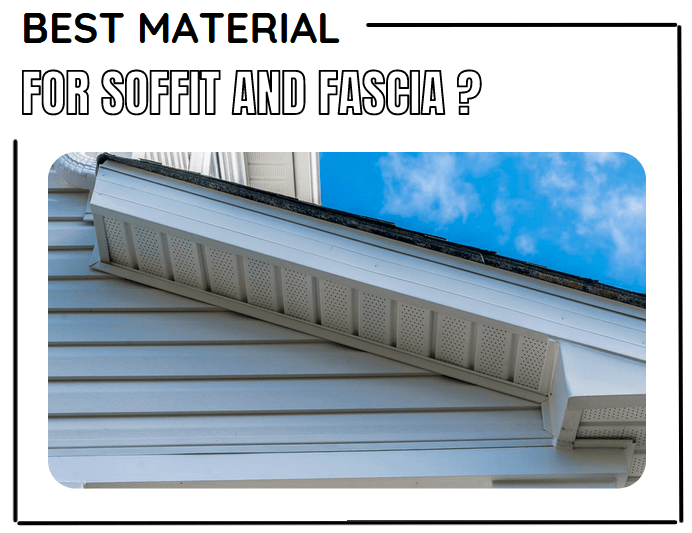When enhancing your home’s exterior, the details are vital. Soffit and fascia, important parts of your home’s architecture, play a crucial role in protecting your home and adding a finishing touch to its overall appearance.
Selecting suitable materials for the soffit and fascia can ensure longevity, durability, and an aesthetically pleasing look. Here, we’ll explore some top contenders and help you choose the best materials for your soffit and fascia needs.
Read also: The Difference Between Soffit And Fascia
What material is used for the sofa and fascia?
Before deciding on a suitable material for the soffit and fascia, let’s check out the materials you can consider. Here are some recommendations:

● Wooden
Wooden soffit and fascia materials are favored for their authentic wood grain appearance and their compatibility with existing wooden structures, offering easy customization through painting. To preserve the aesthetic unity of your home’s exterior, selecting rot- and moisture-resistant varieties such as cedar, redwood, fir, or pine is advisable.
Solid wood or plywood soffits not only add warmth but also enhance the contemporary appeal of your home. To avoid rot and pest damage, opting for pressure-treated wood is wise, helping prevent any moisture buildup.
● PVC
Affordable and lightweight, PVC is commonly used in fascia boards or soffits. However, be cautious of potentially harmful fumes when exposed to high temperatures.
PVC offers cost-effective protection against water leaks and rot, but it may not be the most environmentally friendly choice.
● Unplasticized Vinyl
Unplasticized polyvinyl chloride (uPVC), a soffit material option, is more durable and environmentally friendly than PVC. It’s an excellent choice for covering the underside of your roof’s overhang.
It also resembles various materials, fire-resistant and recyclable. It also provides more appearance variety and comes with three types:
- Solid: the most common and affordable type
- Vented: includes small perforations
- Hollow: includes pre-drilled holes
● Aluminum
Aluminum soffit, although pricier than uPVC, is a versatile building material. It’s easy to work with, water-resistant, fire-resistant, and lightweight, making it ideal for vented soffit designs. However, it requires attic insulation and is prone to denting.
It also protects against bugs; well-vented aluminum can prevent ice dams and related damage. This material also offers customization options through painting.
Read also: How to Insulate a Shed for Free
● Fiber Cement
Fiber cement soffit and fascia, composed of cellulose fiber, Portland cement, and recycled woodchips, offer a sustainable and durable option.
This material mimics the aesthetics of natural wood and fiber cement siding but requires less maintenance. More durable and resistant to mold and water damage, but it might cost more.
Fiber cement materials also tend to last longer, potentially saving money in the long run. In conclusion, it combines the aesthetics of wood with water-resistant characteristics but requires less maintenance than traditional wood.
Here’s How to Choose the Best Material for Soffit and Fascia
Choosing the right materials for your soffit and fascia ensures a balance between functionality, durability, and visual appeal. To meet both your practical requirements and aesthetic preferences, this comprehensive guide will assist you in selecting the best material:
● Consider the Climate
Start by assessing the climate in your area. Opt for moisture-resistant and rot-proof materials if you live in a region with high humidity or frequent rainfall. Vinyl, aluminum, and fiber cement are excellent choices for such environments.
On the other hand, if you reside in a dry and hot climate, materials like aluminum and unplasticized vinyl (uPVC) or vinyl soffit material are recommended for their fire-resistant properties.
● Maintenance Requirements
Another crucial aspect is the level of maintenance you’re willing to undertake. Some people may prefer the aesthetic and warmth of wood despite the higher maintenance needs, while others may opt for low-maintenance options like vinyl or aluminum for ease of upkeep.
● Aesthetics and Compatibility
Take into account the overall look and style of your home. Choose a material that harmonizes with the architectural style of your home to achieve a cohesive and visually pleasing result.
● Budget
Budget is always a factor to consider. Vinyl and aluminum are generally more cost-effective, while wood and fiber cement are pricier. However, long-term durability and maintenance savings may offset the initial investment.
By considering these factors, you can decide to get the best material for the soffit and fascia. Remember, the right choice of material ensures a durable and attractive exterior that you can enjoy for years.


